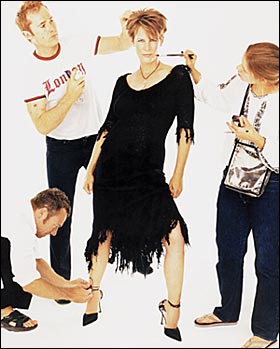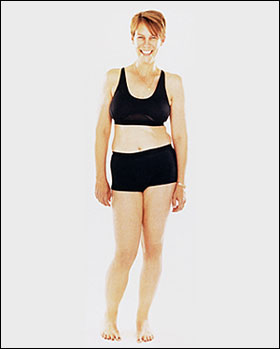n. A change of appearance in which a person is given a simpler look, especially one with little or no makeup and a basic hairstyle.
2002
What is shocking about Jamie Lee's "makeunder" isn't just the sight of a real middle-aged woman in her underwear. For a post-feminist generation of women who were raised to reject artifice before they ever had anything to hide, it is a shock to learn that we have betrayed ourselves. In the struggle for liberation, the battlefield, as Germaine Greer once observed, is still our bodies. Equal partners with our husbands, at the apex of our careers, we are still undone by the sight of ourselves in the mirror. Jamie Lee, by celebrating the real, might be giving us all a lesson. If we aren't grown up enough to be cool with our real selves at 40, when is it going to happen?
1994 (earliest)
The makeover section, where a tatty subject is given a physical reconstruction as a pleasant way of saying "you are a total barker, get your life in order", is good viewing. It's been mooted that a refreshing change would be to see the reverse operation; a sort of makeunder.
Ms Hutton or Ms Bailey could be perfect subjects, with a "before" snap of them in their designer gear and expensive hairdos, followed by a ceremonial removal of makeup, a bad perm job from a smoking, trainee barber, and the donning of a sloppy joe and tracksuit pants.
Ms Hutton or Ms Bailey could be perfect subjects, with a "before" snap of them in their designer gear and expensive hairdos, followed by a ceremonial removal of makeup, a bad perm job from a smoking, trainee barber, and the donning of a sloppy joe and tracksuit pants.
The "Jamie Lee" mentioned in the example citation is actress Jamie Lee Curtis, who, in the September issue of More magazine, appeared in "before" and "after" pictures. The "before" picture (below, left) showed her in all her Hollywood glamour, with perfect makeup, stylish hair, haute couture dress and shoes, and being fussed over by three assistants. The "after" picture (below, right)showed her "authentic self," as she called it: no makeup, no fancy coif, and an outfit consisting of a simple sports bra and spandex briefs that showed off a bit of pudginess. She had had, in other words, a makeunder.




The fuss that followed the publication of these pictures made it seem as though the makeunder was a new phenomenon, but it has been around for a while. Jane magazine has had a "Makeunder" feature since at least 1997, and the Mirror newspaper has had a similar feature since 1999.
